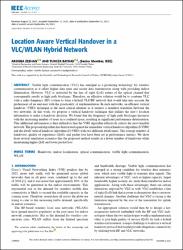| dc.contributor.author | Zeshan, Arooba | |
| dc.contributor.author | Baykaş, Tunçer | |
| dc.date.accessioned | 2021-10-07T05:19:11Z | |
| dc.date.available | 2021-10-07T05:19:11Z | |
| dc.date.issued | 2021 | en_US |
| dc.identifier.citation | Zeshan, A. ve Baykaş, T. (2021). Location aware vertical handover in a VLC/WLAN hybrid network. IEEE Access, 9, 129810-129819. https://dx.doi.org/10.1109/ACCESS.2021.3113286 | en_US |
| dc.identifier.issn | 2169-3536 | |
| dc.identifier.uri | https://dx.doi.org/10.1109/ACCESS.2021.3113286 | |
| dc.identifier.uri | https://hdl.handle.net/20.500.12511/8377 | |
| dc.description.abstract | Visible light communication (VLC) has emerged as a promising technology for wireless communication as it offers higher data rates and secure data transmission along with providing indoor illumination. However, VLC is restricted by the line of sight (LoS) nature of the optical channel that consequently results in light path blockages. Therefore, an effective solution would be to combine VLC with a radio frequency (RF) system to form a hybrid VLC/RF network that would take into account the preferences of an end-user with the practicality of implementation. In such networks, an efficient vertical handover (VHO) technique is the most critical element as it ensures a seamless transition between the two networks. In this work, we propose a vertical handover technique that utilizes the user's location information to make a handover decision. We found that the frequency of light path blockages increases with the increasing number of users in a confined space, resulting in significant performance deterioration. This additional information is then utilized so that the VHO algorithm effectively selects the most feasible network. The proposed algorithm has been tested against the immediate vertical handover algorithm (I-VHO) and the dwell vertical handover algorithm (D-VHO) with two different dwell times. The average number of handovers, quality of experience (QoE), and packet loss have been set as performance metrics. We show from several simulation scenarios that the proposed method results in a fewer number of handovers while maintaining higher QoE and lower packet loss. | en_US |
| dc.description.sponsorship | Türkiye Bilimsel ve Teknolojik Araştırma Kurumu (TÜBİTAK) | en_US |
| dc.language.iso | eng | en_US |
| dc.publisher | IEEE-Institute of Electrical and Electronics Engineers Inc. | en_US |
| dc.rights | info:eu-repo/semantics/openAccess | en_US |
| dc.rights | Attribution 4.0 International | * |
| dc.rights.uri | https://creativecommons.org/licenses/by/4.0/ | * |
| dc.subject | Handovers | en_US |
| dc.subject | Indoor Localization | en_US |
| dc.subject | Optical Communication | en_US |
| dc.subject | Visible Light Communication | en_US |
| dc.subject | WLAN | en_US |
| dc.title | Location aware vertical handover in a VLC/WLAN hybrid network | en_US |
| dc.type | article | en_US |
| dc.relation.ispartof | IEEE Access | en_US |
| dc.department | İstanbul Medipol Üniversitesi, Mühendislik ve Doğa Bilimleri Fakültesi, Elektrik ve Elektronik Mühendisliği Bölümü | en_US |
| dc.authorid | 0000-0001-7300-5804 | en_US |
| dc.identifier.volume | 9 | en_US |
| dc.identifier.startpage | 129810 | en_US |
| dc.identifier.endpage | 129819 | en_US |
| dc.relation.tubitak | info:eu-repo/grantAgreement/TUBITAK/SOBAG/215E311 | |
| dc.relation.publicationcategory | Makale - Uluslararası Hakemli Dergi - Kurum Öğretim Elemanı | en_US |
| dc.identifier.doi | 10.1109/ACCESS.2021.3113286 | en_US |
| dc.identifier.wosquality | Q2 | en_US |
| dc.identifier.scopusquality | Q1 | en_US |



















